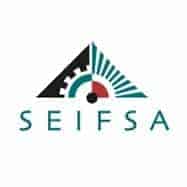Emergency contact details
| Lucio Trentini | 082 449 6270 |
| Rajendra Rajcoomar | 083 788 1386 |
| Louwresse Specht | 082 303 2213 |
| Michael Lavender | 082 459 7678 |
| Theresa Crowley | 082 725 6717 |
| Palesa Molise | 083 507 2746 |
| Nuraan Alli | 083 415 2780 |
SEIFSA welcomes increase in manufacturing production and sales data
JOHANNESBURG, 12th OCTOBER 2021 – The Steel and Engineering Federation of Southern Africa (SEIFSA), welcomed the increase in the growth rate patterns in the metals and engineering (M&E) sector’s production and sales data for the month of August 2021, indicating that, notwithstanding coming off a low base, there are the beginnings of promising indicators in manufacturing sector.
According to manufacturing data released by Statistics South Africa (StatsSA), total manufacturing production improved by 1.8 percent on a year-on-year basis in August 2021, when compared to August 2020, with a month-on-month increase of 7.6 percent from July 2021. Total manufacturing sales increased by 10.9 percent year-on-year in August 2021, with a month-on-month increase of 10.3% from July 2021. Year to date, manufacturing production increased by 11.6 percent, while sales improved by 22.8 percent.
Within the metals and engineering sub-sectors of the manufacturing sector, which accounts for 29% share in total manufacturing production, total production across the 13 sub-categories increased by an average of 9.4 percent in August 2021 year-on-year, with total sales increasing by a high 19.8 percent to reach R79.3 billion in August 2021, with the largest sales value being in the non-ferrous metal products at R18.8 billion. This is augurs well with ABSA Purchasing Managers Index (PMI) tracking industrial activity recovering to 57.9 index level in the month of August 2021 following the impact of the unrest in the month of July 2021.
While the current production data is positive news and encouraging, SEIFSA expects that production and growth patterns to be significantly lower in the months ahead due to disruptions such as a likely COVID-19 fourth wave, persistent and on-going load shedding, and the industrial action in the M&E sector.
SEIFSA is concerned that the industrial action within the sector, poses a huge threat to the South African economic growth recovery project and the steel industry at large, as production and operational activities in most companies have been severely negatively affected.
With the country moving to adjusted lockdown level one restrictions this is the period where companies should be leveraging on these relaxed restrictions; boosting production in line with demand and increasing capacity utilization levels.
If the industrial action continues into the coming weeks, it will deter the recovery of the beleaguered sector immensely. If steel companies are not operational and no production is taking place, there will be further strains on companies to stay afloat amid the high steel prices they are incurring and the implications will inevitably lead to even more job losses which the industry can ill afford.
As one of the backbone sectors of the South African economy, the M&E sector remains a crucial supplier of inputs into major sectors such as construction, mining and other manufacturing sub-industries, and is thus an integral part of economic and industrial development in South Africa. It therefore, remains imperative that wage negotiations be finalised as soon as possible to avoid a repeat of the 2014 episode which cost the South African economy R6 billion to gross domestic product (GDP).
SEIFSA welcomes new board at Annual General Meeting.
JOHANNESBURG, 11 October 2021 – The Steel and Engineering Industries Federation of Southern Africa (SEIFSA) named its new board at the SEIFSA Annual General Meeting.
EICO Engineering Chief Executive Officer Elias Monage who is also a member of the Steel Master Plan Oversight Council, Chairperson and Founder of the Steel Industry Compliance and Support Fund was elected SEIFSA President, while the Federation’s Vice-Presidents are Nonhlanhla Ngwenya, Managing Director at MphoNo Energies and Board Member at KSB Pumps & Valves (Pty) Ltd and Chief Executive Officer of Auto Industrial Group and member of the Steel Master Plan Council Andrea Moz.
Other Board members are Dynamic Fluid Control (Pty) Ltd Chief Executive Officer Tumi Tshelo, Frigoglass South Africa Human Resources Executive Ryan Haynes, Reinforcing Steel Contractors (Pty) Ltd Director Ernest Volschenk, South African Mint Company Managing Director Honey Mamabolo, Director and Chairman of various companies within and outside the M&E Industry Malcolm Mcculloch, Actom Group Chief Executive Officer Mervyn Naidoo and Allied Steelrode (Pty) Ltd Group Chief Executive Officer Arun Chadha.
Welcoming new board members, SEIFSA President Elias Monage said the next coming period will be extremely challenging and will require robust leadership to tackle the policy, regulatory and socio-economic environment in order to position the Federation as the apex employer body in the metals and engineering industries.
Monage welcomed the government’s Steel Master Plan which he said would go a long way in addressing the sectors challenges. He emphasised that SEIFSA is ideally positioned through the nomination and election of industry leaders to the Master Plan Committee. This, he stressed, gives the membership an opportunity to reposition the Federation to greater heights. He furthermore stressed the importance of sharpening the Federations agenda in order to remain relevant in the continent and globally.
Following the successful conclusion of the AGM, SEIFSA was honoured to host renowned futurologist and scenario planner Clem Sunter who emphasized the importance of scenario planning for businesses and organisations
We are confident that the new SEIFSA leadership will build to continue with the excellent efforts of outgoing board members, with the newly elected members, adding their own dynamism, experience and wisdom.
COSATU’S intended National Day of action 7 October 2021.
Management may be aware, from recent media reports, that the Congress of South African Trade Unions (COSATU) is preparing for a national day of action in the form of a national stay-away on Thursday, 7 October 2021.
This Management Brief provides some basic background to the issue and guidance to Management in dealing with the intended protest action.
PROTEST ACTION AND THE LABOUR RELATIONS ACT
COSATU has been quoted in various media reports that it would stage a stay-away or a socio economic strike in protest against corruption, job losses, retrenchments and the fight against gender based violence on 7 October 2021.
The Labour Relations Act (LRA) permits registered trade unions or a federation of trade unions, such as COSATU, to undertake protected protest action to promote the social and economic interests of workers, provided that they observe the procedural requirements contained in Section 77 of the LRA.
It is important to note that protest action in terms of Section 77 of the LRA is only protected if the issue in dispute has been considered by NEDLAC and the applicant concerned has given to NEDLAC 14 days’ notice of its intention to proceed with such protest action. In the absence of these conditions, any protest action would not be protected.
It has been confirmed that COSATU has filed a Section 77(1)(b) notice with NEDLAC, advising of its intention to participate in a socio-economic strike on 7 October 2021.
The NEDLAC Section 77 Standing Committee has determined the notice to be compliant with the administrative requirements of the LRA.
Consequently, employees participating in any form of stay-away or protest activity on 7 October 2021 will be protected by the normal rules regarding protected protest action to promote or defend the socio-economic interest of workers, namely: no-work, no-pay and no-disciplinary action.
RECOMMENDED MANAGEMENT ACTION
SEIFSA recommends that Management adopts the following course of action in dealing with any stay-away on 7 October 2021:
Inform all workers that any absences related to the protest action will be treated on the following basis:
- No work, no pay;
- No disciplinary action;
A shift for leave pay and leave enhancement pay qualification purposes will be lost in respect of the day’s absence; and - Any overtime worked during the course of the week will be paid at ordinary rates to make up for the lost ordinary working hours on 7 October 2021.
The Staff of SEIFSA’s Industrial Relations and Legal Services Division are available on (011) 298-9400 to provide any further advice and/ or assistance to Management on the contents of this Management Brief.
SEIFSA encouraged by upward trajectory in selling prices.
JOHANNESBURG, 30th SEPTEMBER 2021 – The Steel and Engineering Industries Federation of Southern Africa (SEIFSA), welcomes a further improvement in the Producer Price Index (PPI) for intermediate manufactured goods. Industry can be encouraged by the latest data, which shows the PPI for intermediate goods remaining in an expansionary terrain.
Commenting after the release of the results published by Statistics South Africa (Stats SA) today, SEIFSA Economist Ms Molise said that the results showed that on a year-on-year basis, prices for intermediate manufactured goods (measured in factory gate prices) marginally increased from 17.6% in July 2021 to 17.7% in August 2021, the increase is consistent with the annual change in the PPI for final manufactured goods, which also increased and from 7.1% in July 2021 to 7.2% in August 2021. The increasing trend in the PPI for intermediate manufactured goods is encouraging, as it is a good proxy for selling price inflation in the M&E sector and its improvement provides leeway for producers to improve on margins, Ms Molise said.
Ms Molise said, given that the PPI for intermediate manufactured goods has maintained an upward trajectory and with the eased lockdown level 2, businesses should therefore, leverage off the improvement in selling price inflation.
As business conditions have generally been tough amid low levels of domestic demand and higher intermediate input costs, compounded by the COVID-19 pandemic, recent lootings, increasing electricity prices and fuel prices, declining employment numbers and a weaker exchange rate, it is imperative that companies in the M&E sector take advantage of rising selling prices and the impending up-tick in demand from inter-linked industries, in order to boost production trends, Ms Molise concluded.
NUMSA indicates intention to commence with strike action on 5 October 2021.
Members will be aware that the bargaining council has issued a certificate of non-resolution confirming that the dispute declared by NUMSA against SEIFSA (representing member Associations), NEASA, SAEFA and the CEO remains unresolved.
The issuing of this certificate opens the way for potential strike and lock-out action but only once strike and picketing rules have been agreed between all the parties and in the absence of such agreement, imposed by the CCMA.
Once strike and picketing rules have been finalised, NUMSA will still be legally obliged to serve 48 hours’ notice of its intention to participate in protected strike action. SEIFSA in response, has already complied with all the legal obligations necessary in order to reserve the right of member companies, who may elect to lock-out striking employees.
To date strike and picketing rules have not been finalised and no formal 48 hour notice has been served. Importantly, SEIFSA, through the duly appointed Main Agreement Negotiating Team is continuing to test and explore all possible settlement possibilities.
We have now become aware through various communiques doing the rounds in the industry, that following the convening of the NUMSA National Shop Stewards Council and a Special National Executive Committee (NEC) that took place over the weekend, a decision was taken that strike action will commence on 5 October 2021.
In the light of this latest development, members are once again urged to plan for the worst case scenario and ensure that adequate stock, material, enhanced security etc. are in place. We will immediately advise the membership the moment we receive formal notice of strike action.
If it becomes inevitable that strike action will materialise, we will immediately on receipt of the formal 48 hours’ notice of intended strike action, circulate the requisite company lock-out and shut-out letters.
We will continue to keep all members fully informed as developments unfold.
Production and sales data in the manufacturing sector reflects the impact of the unrest in the month of July.
JOHANNESBURG, 09th SEPTEMBER 2021 – The Steel and Engineering Federation of Southern Africa (SEIFSA), says the manufacturing production and sales data reflects the negative impact of the July’s unrest in Gauteng and KwaZulu-Natal provinces.
According to manufacturing data released by Statistics South Africa (StatsSA), total manufacturing production declined to -4.1% year-on-year in July 2021, when compared to July 2021, with a monthly decline of -8.0% from June 2021. Total manufacturing sales increased by only 3.2%, down from a high of 29.3% in June 2021, while declining marginally by 13.1% from June 2021. However, some encouraging news is that year to date, manufacturing production increased by 12.9%, with sales improving by 24.8%.
Speaking after the release of the numbers, SEIFSA Chief Economist Chifipa Mhango said that the sub sectors of manufacturing account for 29% share in total manufacturing production. Total production across all 13 sub-categories increased by an average of 4.5% in July 2021, down from a high of 27.6% in June 2021 year on year, with total sales increasing by 12.1% in July, down from a high of 38.6% in June 2021. M&E total manufacturing production sales were R66.7 billion in July, down from R81 billion in June 2021. The largest sales value in the month of July being in the non-ferrous metal products at R15.3 billion.
“As one of the backbone sectors of the South African economy, the Metals and Engineering (M&E) sector remains a crucial supplier of inputs into major sectors such as construction, mining and other manufacturing sub-industries and is thus an integral part of economic and industrial development in South Africa.” Mr Chifipa said.
“With that in mind, what is clear is that while the focus of the South African Government is on economic policy and its recovery plan, there is an urgent need to also address the socio-economic challenges facing our country, as there can be no real growth in an unstable socio-economic environment,” Mr Chifipa said.
SEIFSA welcomes a positive trend in economic GDP growth rate for South Africa in second quarter of 2021.
JOHANNESBURG, 07th SEPTEMBER 2021 – The Steel and Engineering Industries Federation of Southern Africa (SEIFSA) is encouraged by the latest real Gross Domestic Product (GDP) data released by Statistics South Africa (Stats SA) today, affirming an uptick in economic growth of the domestic economy from the the first quarter of 2021 to 1.2%.
The uptick in GDP is certainly a welcome development, especially given the current economic environment against the backdrop of rising unemployment levels, rising input costs, increasing energy costs and the Covid-19 pandemic. Encouragingly, the agriculture sector and mining showed the best growth rates at 6.2% and 1.9%.
Gross Fixed Capital Formation (GFCF) data released along-side the GDP figures is also supportive of the positive trends we are seeing in GDP and production figures, as GFCF decreased by a marginal 0.9%% in the second quarter of 2021. The increase was attributed to increases in machinery and transport equipment.
SEIFSA Chief Economist Chifipa Mhango, said it is important to note that the Metals and Engineering Industry is heavily reliant in the performance of the Mining, Construction and Building industry and other manufacturing market segments to survive, as these are the key sectoral markets.
“It is evident that during the time when the South African economy had a strong injection of infrastructure projects being implemented in the periods of 2003 to 2010 in the energy sector, as well as projects related in the 2010 World Cup, the Manufacturing Sector, and the Metals and Engineering Sector in specific, also experienced a boom in production and capacity utlisation of over 85%,” he said.
Mr Mhango said it should be encouraging to see a return in demand for the Metals and Engineering industry products in the economy as the South African Government commits to R792.1 billion public infrastructure spending into the next three fiscal years. However, to guarantee stock availability, the industry needs to move back to higher levels of capacity utilization from the current Covid-19 driven levels of 75%.
Another positive element in the StatsSA data release of today is the increase in exports of goods and services of 4.0% in the second quarter of 2020, mainly attributed to increases in mineral products, precious and semi-precious stone sand vehicles” Mr Mhango concluded.
Dispute discussions continue between employers and trade unions in an effort to stave off industrial action.
At today’s CCMA facilitated bargaining council dispute sub-committee meeting held between the trade unions, the SEIFSA affiliated Employer Associations, NEASA and SAEFA, all the parties agreed to continue negotiations in a serious endeavour to stave off the possibility of industry industrial action.
Members will be aware that negotiations are taking place under the auspices of the bargaining council’s constitution which prescribes that once a dispute has been declared and a process has been agreed on how best to deal with the deadlock - on the expiry of a thirty day window, any party to the dispute may call for the issuing of a certificate of non resolution. With NUMSA having declared its dispute against all the employer organisations on the 29 July and SEIFSA on behalf of the Associations having countered with its dispute against NUMSA on 2 August, the certificate of non-resolution could have been called for as early as today.
Today’s session, facilitated by a CCMA Commissioner, ended with the parties agreeing that the life of the sub-committee be extended to Tuesday, 14 September 2021, at which point the parties will report that an agreement has been reached or alternatively and notwithstanding the best endeavours of all the parties, the parties have failed in their efforts to break the deadlock.
Members will be aware that the SEIFSA affiliated Associations settlement offer is based on four inter-related pillars namely:
- Duration;
- Wage increases and a wage model;
- Extension; and
- A special phase-in dispensation aimed at encouraging greater support for centralised collective bargaining which is now, more than ever, needed to ensure the survival, recovery, growth and sustainability of the industry in an environment of industrial peace, stability and certainty.
This offer sees workers receiving a 4, 4% increase this year, a CPI plus 0.5% increase in 2022 and CPI plus 1% increase in 2023, with a floor and ceiling of 3% and 6% in years 2 and 3 guaranteeing workers not less than a 3% or 6% increment plus the cost of living adjustment of 0.5% and 1% in years 2 and 3 respectively.
The offer for this year translates to the following impact on workers’ pay packet:
| Rate | Current Minimum Wage Rate 2020 | Guaranteed Personal Increase | New Entry Level Wage Rates 2021 |
| R c | R c | R c | |
| A | 84,75 | 3,73 | 88,48 |
| AA(6) | 80,83 | 3,56 | 84,39 |
| AA(start) | 77,18 | 3,40 | 80,58 |
| AB | 73,73 | 3,24 | 76,97 |
| B | 70,53 | 3,10 | 73,63 |
| C | 67,96 | 2,99 | 70,95 |
| D | 66,58 | 2,93 | 69,51 |
| DD | 61,76 | 2,72 | 64,48 |
| DDD | 59,10 | 2,60 | 61,70 |
| E | 56,47 | 2,48 | 58,95 |
| F | 54,10 | 2,38 | 56,48 |
| G | 51,65 | 2,27 | 53,92 |
| H | 49,55 | 2,18 | 51,73 |
Negotiations will continue in earnest between all the parties and every reasonable effort will be made to avoid a breakdown in negotiations which will open the way for industry strike and lock-out action.
Notwithstanding our commitment to working around the clock to avoid industrial action, members are nevertheless urged to put in place measures, including but not limited to making provisions for stock, material, enhanced security etc. in order to be properly prepared should negotiations between now and the 14 September break-down.
We will immediately advise the membership the moment we are made aware that industrial action is imminent.
We will continue to keep all members fully informed as developments unfold.










